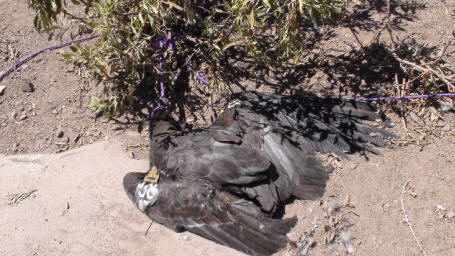|
July 16, 2009
CONDOR FOUND STRANGLED BY
ABANDONED ROPE IN LOS PADRES NATIONAL FOREST
ForestWatch
to Organize Volunteers to Remove Trash and Other Hazards to the
Endangered Bird

Earlier this week, a California
condor known as 358 was found lifeless on a ledge overlooking
a waterfall in the Los Padres
National Forest. The bird - one of a flock of about 40 in the
southern Los Padres - died after its neck became
tangled by an abandoned piece of rope left behind by careless
hikers or climbers.
In response to this incident, ForestWatch
announced that it will be organizing
several cleanups and regularly monitoring the area to keep it free
of items that are hazardous to condors, including microtrash.
On Monday, a hiker in the area
found the bird and called the U.S. Forest Service, who relayed
the information to the U.S. Fish & Wildlife Service's Condor
Recovery Program. The FWS sent out a team to retrieve the bird
on a rocky ledge atop the 200-foot waterfall, and delivered the
bird to the San Diego Zoo for a necropsy to determine the
official cause of death.
Condor biologists who visited
the site believe that the condor was probably tugging at the
rope, somehow got tangled in it, and could not escape. "They
don't have opposable thumbs and they are curious, and that can
get you into trouble," said Michael Woodbridge of the FWS.
"Anything left in the backcountry can have an effect on condors.
The bottom line is pack out your stuff."
According to the Forest
Service, the Tar Creek Trail is not an official trail because it
passes through the Sespe Condor Sanctuary, an area that is
closed to public entry. Despite the closure, the area is still
occasionally used by hikers and climbers. Lesson: If you decide
to visit this area despite the closure, pack out all your
stuff!
In Memoriam:
Condor 358
March 30, 2005 -
July 2009

Condor 358 (far left)
doing what he liked doing the best -
hanging out with his buddies in the sun atop Tar Creek Falls.
Photo taken May 2009
Condor 358 was a young,
four-year-old condor who was born at the World Center of Birds
of Prey outside Boise, Idaho. A year later in 2006, he was
transported to the Bitter Creek National Wildlife Refuge
adjacent to the Los Padres National Forest and released into the
wild. Not yet of breeding age (condors typically start breeding
at 6 and can live for several decades), Condor 358 was proving
to be one of the more dominant youngsters in his flock, roosting
higher than other birds in trees and getting first dibs on food.
Because of this dominance, Condor 358 likely would have been
successful in mating. "We had pretty high hopes of him having a
long productive life in the wild," said Woodbridge.
One hiker who frequented this
area and saw Condor 358 just days before it died had this to
say:
Condor 358 always seemed to be
hanging out more than the others. He liked to stand at the end
of the cliff and spread his wings. On one of my last visits I saw five Condors including 358 on top of the
waterfall. My friend and I noticed that a couple of them were
tugging on a rope or strap that someone had left connected to a
rock at the end of the waterfall. 358 was using his beak to
pick and nibble at the rope. After the Condors had left the area
to fly around, we quickly went over to the rope which turned out
to be a nylon strap and cut it away. It looked to me like
someone used the strap as a way of climbing down the 200 foot
waterfall. We took the strap home with us. I hope by doing this act I helped save at least one
Condor's life. That was the last time I remember seeing Condor
358.
Condor 358's death leaves 188
condors living in the wild, including 45 in the
southern Los Padres.
|

